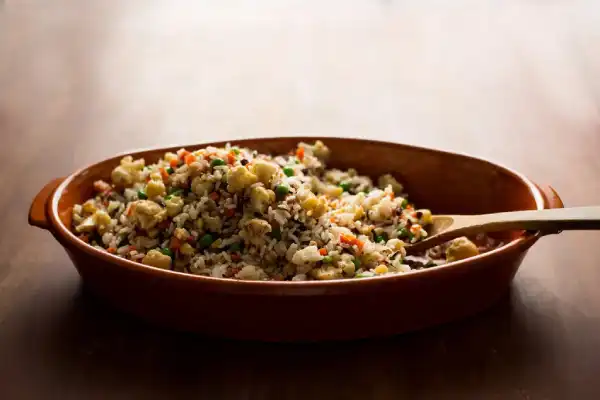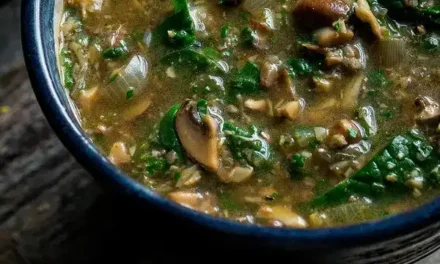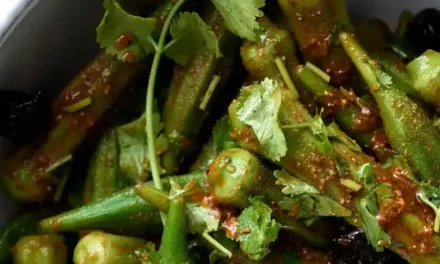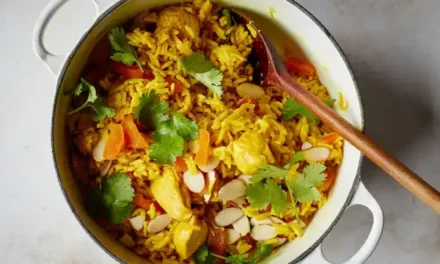Introduction:
If you’re looking for a flavorful, nutritious, and naturally gluten-free side dish, this gluten-free basmati rice pilaf with cauliflower, carrots, and peas is a perfect choice. Growing up, rice pilaf was a staple at our family dinners, and this version is a colorful, veggie-packed twist that delivers both taste and texture. What makes this dish stand out is the use of fragrant basmati rice combined with tender cauliflower, sweet carrots, and fresh peas, making it not only filling but also rich in nutrients.
Basmati rice is gluten-free and packed with essential carbohydrates that fuel your body with energy. The addition of vegetables not only boosts the nutritional profile but also adds color and crunch to the dish. The result is a light, fragrant pilaf with subtle spices and a delightful texture—perfect for pairing with your favorite main course or enjoying on its own as a wholesome, vegetarian meal. Whether you’re serving this as a side for a family dinner or prepping for the week ahead, this recipe is easy to make, customizable, and full of fresh flavors.
Ingredients:
For the Pilaf:
- 1 cup basmati rice (rinsed and soaked for 30 minutes)
- 1 tablespoon olive oil or ghee
- 1 small onion, finely chopped
- 1 carrot, diced
- ½ cup peas (fresh or frozen)
- 1 cup cauliflower florets
- 1 teaspoon cumin seeds
- 1 bay leaf
- ½ teaspoon turmeric powder
- 1 cinnamon stick
- 2 cups vegetable broth (gluten-free)
- Salt and pepper to taste
For Garnish:
- 2 tablespoons fresh cilantro, chopped
- A squeeze of lemon juice
Step-by-Step Instructions:
1. Preparing the Vegetables:
- Start by rinsing the basmati rice under cold water until the water runs clear, then soak it in cold water for about 30 minutes. Drain and set aside.
- Heat olive oil or ghee in a large skillet or pot over medium heat. Add cumin seeds and sauté until they start to sizzle and become fragrant.
- Add the chopped onions and cook until translucent, about 3-4 minutes. Stir in the diced carrots and cauliflower florets, cooking for another 4-5 minutes until the vegetables start to soften.
2. Cooking the Rice:
- Add the bay leaf, turmeric, and cinnamon stick to the skillet, stirring well to combine with the vegetables.
- Pour in the drained basmati rice, stirring gently to coat the grains with the spices and vegetables. Cook for 1-2 minutes until the rice is lightly toasted.
- Add the vegetable broth, peas, salt, and pepper. Bring to a boil, then reduce the heat to low. Cover and let it simmer for 15-20 minutes, or until the rice is fully cooked and the liquid has been absorbed.
3. Fluffing and Serving:
- Once the rice is done, remove it from the heat and let it sit, covered, for an additional 5 minutes. This allows the flavors to meld and ensures the rice is perfectly tender.
- Fluff the rice with a fork, removing the bay leaf and cinnamon stick.
- Garnish with fresh cilantro and a squeeze of lemon juice before serving.
Tips for Success:
- Soaking the Rice: Soaking basmati rice helps it cook more evenly and makes the grains fluffier. Don’t skip this step for the best results.
- Vegetable Size: Chop the vegetables into uniform, small pieces to ensure even cooking throughout the pilaf.
- Avoid Stirring Too Much: After adding the broth, resist the urge to stir the rice too often as this can break the grains and make the pilaf mushy.
Recipe Variations:
- Add Protein: To make this a heartier meal, you can add cooked chicken, shrimp, or tofu to the pilaf.
- Spicy Version: If you enjoy a bit of heat, add a chopped green chili or a pinch of red pepper flakes while sautéing the onions.
- Nuts & Dried Fruit: For added texture and flavor, stir in toasted almonds or cashews, and a handful of raisins or dried cranberries during the last 5 minutes of cooking.
Serving Suggestions:
This basmati rice pilaf pairs wonderfully with grilled meats, curries, or roasted vegetables. It’s also delicious as a light main course served with a side of raita (yogurt sauce) or a fresh cucumber salad. The vibrant colors and delicate spices make it a great addition to any meal.
Storage & Reheating Instructions:
- Storage: Store any leftovers in an airtight container in the refrigerator for up to 3 days.
- Reheating: Reheat in a microwave or on the stovetop with a splash of water or broth to prevent the rice from drying out.
Nutrition Information (Per Serving):
- Calories: 220
- Protein: 6g
- Fat: 4g
- Carbohydrates: 40g
- Fiber: 5g
- Sodium: 400mg
Cost Estimation:
- Approximate cost per serving: $2.00
- Budget Tips: Use frozen vegetables if fresh ones are out of season or more expensive. Buying basmati rice in bulk can also help save costs in the long run.
Check out our gluten-free red cabbage dish for more ways to enjoy flavorful dishes.
Health benefits of basmati rice.
Did you try this gluten-free basmati rice pilaf with cauliflower, carrots, and peas recipe? Leave a comment below and let us know how it turned out! Share your variations, and don’t forget to pin this recipe on Pinterest or tag us on Instagram using #HealthyPilaf.





